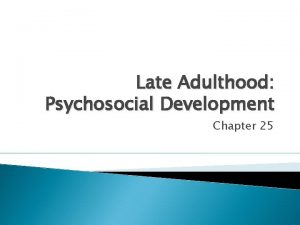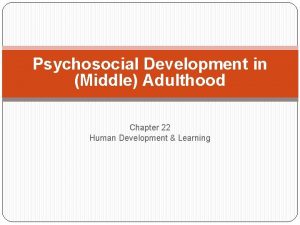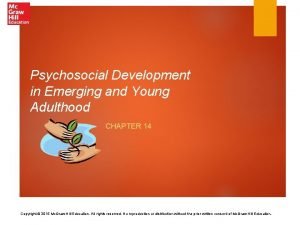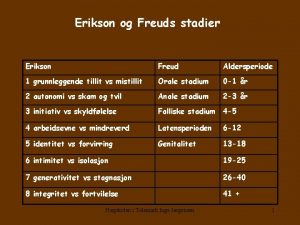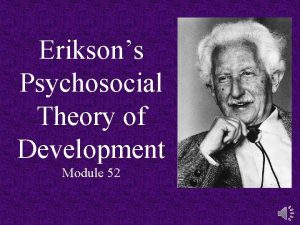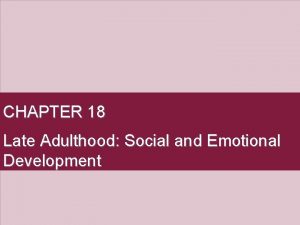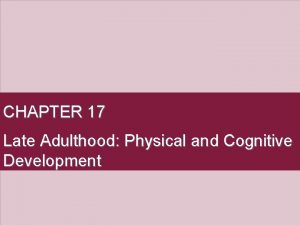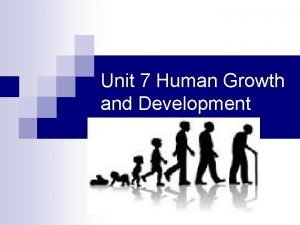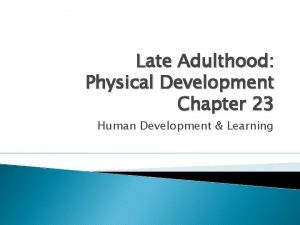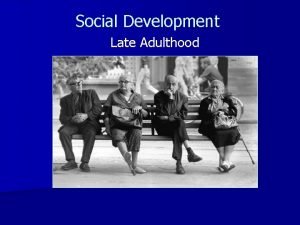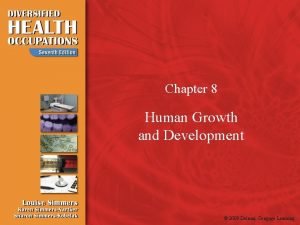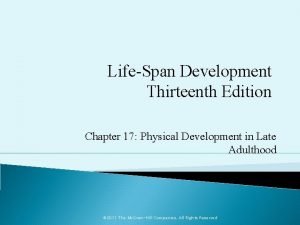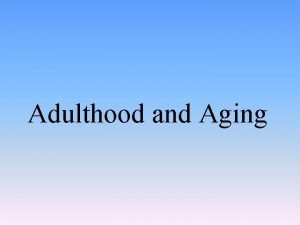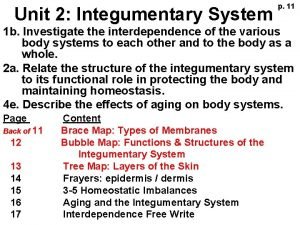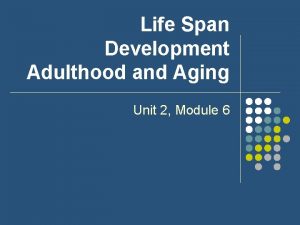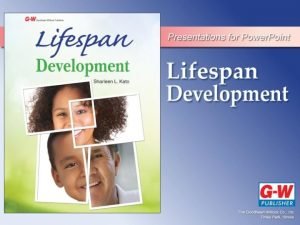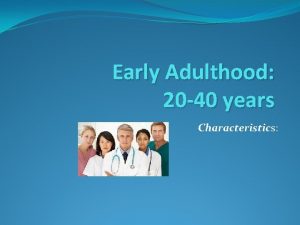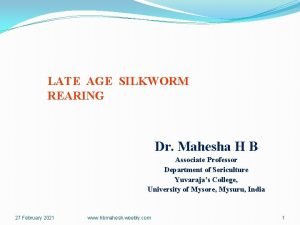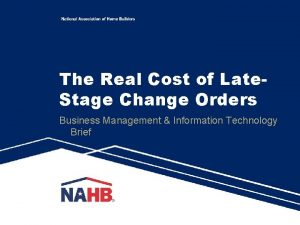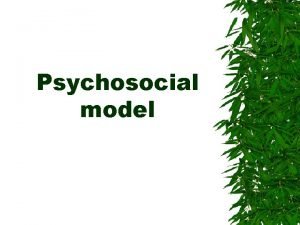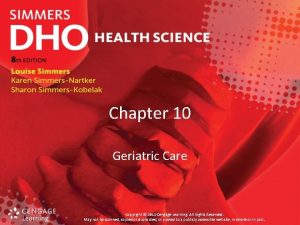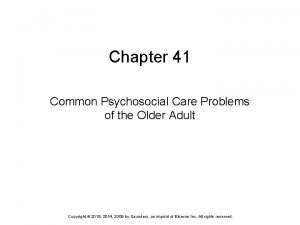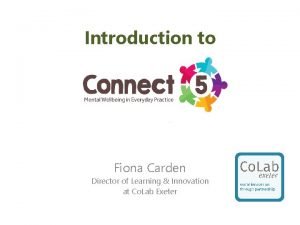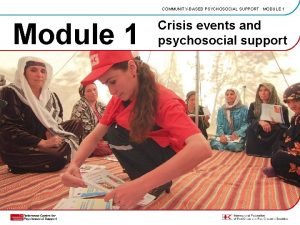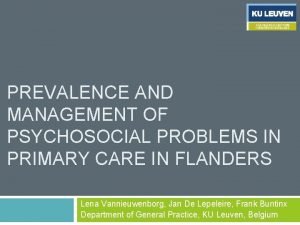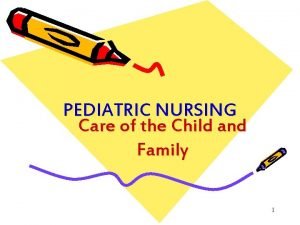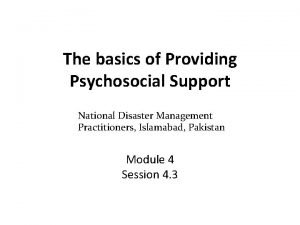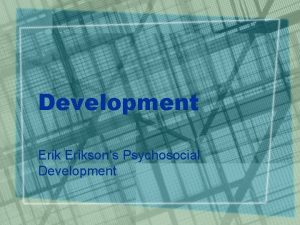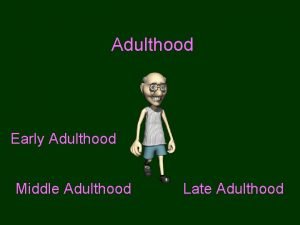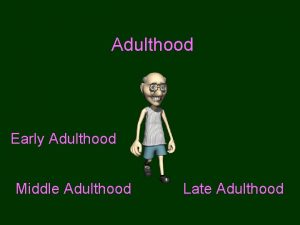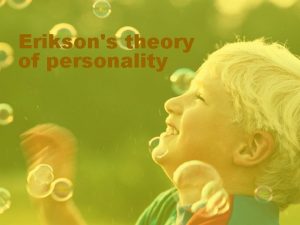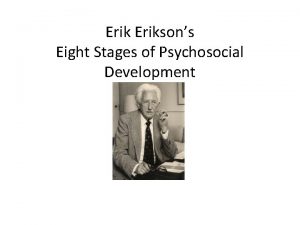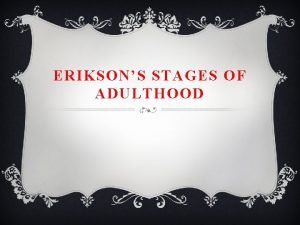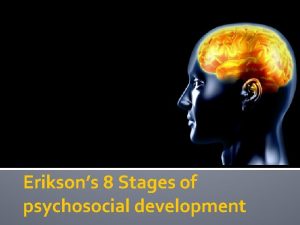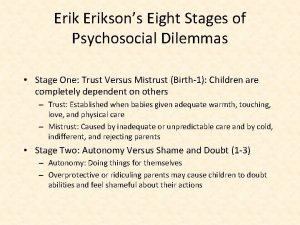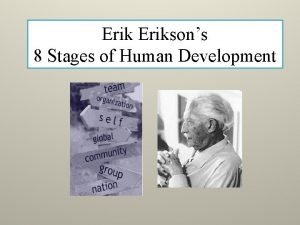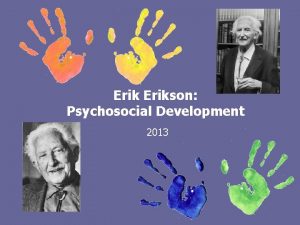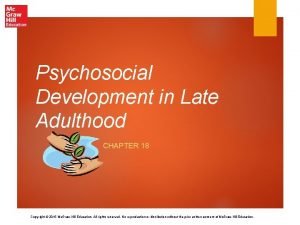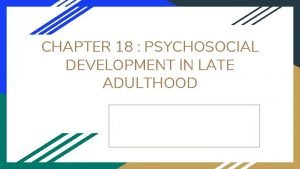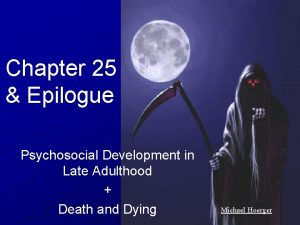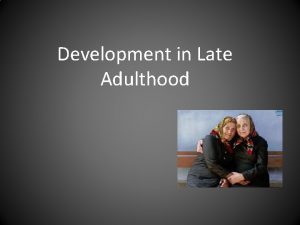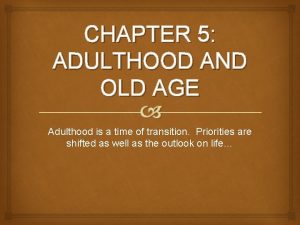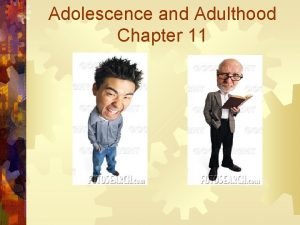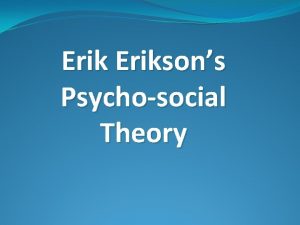Late adulthood Age 60 75 Eriksons psychosocial stage














































- Slides: 46

Late adulthood Age 60 -75

Erikson’s psychosocial stage in later life Integrity vs. Despair According to Erikson, reaching integrity means reviewing one’s life and making peace with it. Having a sense of usefulness and meaning in present life Having a sense of self-efficacy; feeling in control Using emotion regulation is key – making the most of difficult situations such as chronic disease.

Understanding Later Life The median age of the population (the cutoff age at which half of the population is older and half is younger) is now middle age in Europe and Asia. In Europe, 1 in 4 people will be over 65. In America, 1 in 5 will be over 65.

Changing world Since 1900, technology and advancement has increased life expectancy on average of 30+ years Current life expectancy in US at 78+ years old – at 1900, life expectancy at 47 in US Japan has the highest life expectancy at 82 years * Vary according to race, age, environmental factors such as disease outbreak and war How long will you live?

Biological theories aging Cellular clock theory Ideas maximum number of times the human cells can divide is about 75 -80 with less capability to divide as get older Free radical theory Idea we age because inside our cells normal metabolism produces unstable oxygen molecules as we age leading to breakdown Mitochondrial theory As we age the mitochondria decays, the cells needed to supply energy for function Hormonal stress theory Idea aging in hormonal function lowers resiliency to stress and increase chance of disease

Exploring Two Elderly Stages Young-old (sixties and seventies) Typically healthy, relatively wealthy Old-old (80 and older) More likely to be physically frail and poor ü These two groups help explain contradictory stereotypes about later life. § The image of the vital sixty-something embarking on new experiences vs. the lonely, aged person languishing in a nursing home

Physical changes

The aging brain The slowing , shrinking brain The brain loses 5 -10 of weight between ages 20 and 90 Prefrontal area shrinks fastest (working memory) Slowing of function accelerates The adapting brain New brain cells can still develop throughout life Dendrite growth increase until very old age may compensate for slowing of function

The immune system Take longer to heal More prone to susceptible illness Malnutrition in aging further compromises immunize system

Physical appearance and movement Wrinkles Age spots Bone loss and shrinkage Arthritis and joint mobility Hair loss What do we do to “combat father time”

Three Basic Principles of Age-Related Disease 1. Chronic disease is often normal aging “at the extreme. ” Moderate physical losses are normal; extreme changes are considered chronic. Bone density loss, when extreme, is called osteoporosis. Arthritis is the top-raking chronic illness in later life. Many age-related diseases are not fatal, but interfere with ADLs (activities of daily living). 2. ADL impairments – difficulty performing everyday tasks that are required for living independently Become far more frequent among the old-old as the number of chronic diseases accumulates 3. Lifespan has a defined limit. Aging process has a fixed end. But, the 100 -plus group is the fastest-growing age group of all!

What affects the physical aging path? Socioeconomic status Ethnicity Gender Age

Socioeconomic status, aging, and disease § Socioeconomic/health gap − affluent people living longer and enjoying better health § This occurs universally (happens in every nation). § The relationship between income and illness begins in middle § age. However, accelerated aging process begins at the beginning of life (fetal programming hypothesis). ü ü Low birth weight, which is often linked to social class, can cause obesity and poor health later in life. Diet, illness, and life stresses can lead accelerated aging. § The poverty-illness relationship is bidirectional. ü ü Childhood illness can lead to poverty (missing school, less likely to attend college). Poverty can lead to poor choices in later life (smoking, poor nutrition, less exercise, less access to good health care).

Ethnicity, aging, and disease Despite poverty, Hispanic Americans seem to fair better against physical aging than African-Americans. African Americans are more susceptible to illness and premature death than any other ethnic group. Be careful not to blame the person for the many forces that affect aging due to the “toxic” environment of being poor.

Gender, age, and disease Women survive longer due to less life stressors, support from family and friends, their second X chromosome. ü ü ü Due to fewer heart attacks Presence of estrogen helps slow aging process May live longer but frail Men are twice as likely to die from a heart attack earlier in life (it’s biological). Women are more prone to illnesses that cause problems with ADLs but are not fatal. But women rank higher on sickness indicators, such as seeing a doctor throughout adult life. Both nature (biology) and nurture (accessing health care and awareness of health concerns) explain why women outlive men in every developed world nation by at least 4 years.

Health in later adulthood

Health problems Heart disease the leading cause of death Body processing still continue to break down More at risk to infectious illness such a influenza and pneumonia Mobility and balance Tai chi yoga

Sensory-motor changes with age Vision Hearing Motor abilities

Normal Vision Changes Presbyopia – age-related difficulties with seeing close objects universal change that happens in mid-life often leads to the need to purchase reading glasses Poorer dark vision cannot see as well in dimly lit places More troubles with glare being blinded by bright light shining in the eye

Understanding hearing in later life Hearing loss is very common in later life, causing as many barriers as vision loss. Hearing impairments may be more problematic than vision problems because they limit the ability to connect with the human world through language. One in three older adults suffers from hearing loss. Men are more likely than women to develop hearing loss. Have an environmental cause − exposure to noise Problems may increase in the i. Pod-oriented culture!

Motor performances § Primary motor ability change − slowness § Caused by loss in information-processing speed § Primary reason why older adults experience such prejudices § People become annoyed by the lack of their ability to keep up with the fast-paced, taskoriented society. § Consider your reaction to an elderly person who is driving slowly. § Problems with reaction time – decline in the ability to respond quickly to sensory input Poor reaction time can cause problems with making quick decisions (accelerating when traffic light turns green) or performing some routine tasks (counting change). § Changes in skeletal structures affect motor abilities: Osteoarthritis − wearing away of joint cartilage Osteoporosis − bones become porous, brittle, and fragile; tend to break easy Women are more susceptible. Hip fractures are a common problem due to skeletal changes. ü Most common risk factor for nursing home admissions

Driving in Old Age Vision, hearing, and reaction-time problems converge to make driving more dangerous especially in the old-old years. § This chart refers to accidents per miles driven. The elderly drive less than the young, so overall their accident rates are much lower. § Age accident rates are higher with the elderly than high-risk populations (teenagers and emerging adults).

Sexuality Sex still available More than 60% of those over 65 identify still having sex at least once a month Beware of risk of STD Fasted growing group of those with HIV in the 60 year + category

Work and retirement

Examining Retirement Most think of the U. S. retirement age as 65. Actually, the average for collecting full Social Security benefits is now 66. It will be 67 for people born after 1970. True age of retirement is 60 rather than 65. Because, on average, we live another 20 years after retirement, it is now a full stage of life. Retirement depends on governments offering programs enabling their citizens to live without working. Therefore, in countries without government-sponsored programs (mainly in the developing world), people must stay on the job until they physically cannot work.

Retirement Has different meanings for different persons Often working less than full time year round In 1900, nearly 70% of those over 65 (remember less than 3% of population) still working – in 2004, less than 20% despite having more in this population

Retirement in the United States Out of 100 people who starts working at the age of 25, by the age 65: * 1% are wealthy * 4% have adequate capital stowed away for retirement * 3% are still working * 63% are dependant on Social Security, friends, relatives or charity. * 29% are dead.

Retirement and Other Countries Germany: Mercedes-like model (wonderful government support First government-funded retirement program developed in nineteenth century System designed to keep people financially comfortable Government replaces ¾ of person’s working income for life Stipend increases to standard of living, so people get more financially comfortable with age United States: Used car model (deteriorating pensions and savings; some guaranteed government support) Social Security – government-funded program Pension plans – savings accounts of employees Model is based on personal initiative.

Deciding to retire Factors that many consider Enough money to live without working (top-ranking motivation) Physical ability to keep working (more apt to occur among lowincome workers—especially those in physically demanding jobs) Age discrimination Job satisfaction Age discrimination can affect retirement decisions: Defined as illegally laying off workers or failing to hire or promote them on the basis of age P Is illegal in the United States P However, many corporations offer early buyouts. P May be used by large corporations due to high salaries of older employees

Adjustment to retirement Can you live on social security –how much do you have saved? Loss of work as support system Finding what to do with the time Do you define who you are by work?

Cognitive development

Attention and memory Several aspects decline with age Speed of processing decreases Decreased short term memory – need to write stuff down more More likely to need more time to process information but given time, most still can

Mental health

Substance abuse Nearly 20% of those age 65+ meet criteria for substance abuse Women more likely to become heavy drinkers later in life Abusing and mishandling medication 65+ account for 14% of our population but consume over 25% of total prescribed medication

Depression

Dementia Used to be and is still called senility by laypersons Comes on slowly over many year Course may vary depending on person Prevalence – 1% of population 65 -74 years; 4% of age 75 -84 years; and 10% of those over age 84 Dementia usually comes in four main forms

Families and social relationships

Widowhood Death of a spouse – life’s most traumatic change Exploring mourning: Obsession with the loved one and the events surrounding the death Impulse to search for one’s spouse (mirroring the attachment response that occurs in infancy) Expect widowed people to “improve”

Widowhood 14% of men and 43% of women over age 65 identify self as widowed Widowers often have greater chance of depression than widows 61% of men and 19% of women involved in a romantic relationship within 2 years of widowhood Widowhood mortality effect – risk of death that occurs among surviving spouses Men are more at risk, especially old-old men. Anyone with limited options for remaking a new life People highly dependent on just a spouse People in male-dominated cultures

Volunteerism 23% of those over 65 considered at least part time volunteer work High rates of volunteerism correlate with increased life satisfaction and improve perception of physical health Some promote cognitive and memory maintenance or improvement

Various Cultures and Caring for the Elderly § Asian countries are turning to Western society model. § Scandinavian countries offer positive models for elder care. § Family members still take primary responsibility for elder care. § However, government often provides home health services allowing people to stay in their homes (“age in place”) § Money provided to help remodel home § Presence of multigenerational villages

Abuse

Elder abuse and victimization

Nursing Home Care Nursing homes or long-term care facilities Designed for people with basic ADL impairments Provides 24 -care intensive care Residents are mainly very old and female. Entry often occurs after trauma: Psuch as breaking a hip Pwhen the person has dementia People without families (or the money for assistedliving facilities) are most at risk of entry.

Alternatives to Institutionalization Continuing-care retirement Residential complex that provides different levels of services Independent apartments to nursing home care Designed to provide person−environment fit Allows person to not burden family members Assisted-living facilities For those who are experiencing ADL limitations but do not need 24 -hour care Offers care in a less medicalized setting More of a homey setting Residents have private rooms and personal furniture. Day-care programs For elderly who live with families Provides place for impaired elderly to go when caregivers are working Helps family members continue to care for loved one in the home by providing support and help with care while not giving up other responsibilities Home health services “in place” care – provides care in home Paid caregivers provide help with ADLs – cooking, cleaning, bathing

Celebrities in late adulthood Dame Helen Mirren (70) Donald Sutherland (80) Harrison Ford (73) Betty White (94) Queen Elizabeth (90)
 Psychosocial development in late adulthood
Psychosocial development in late adulthood Ego strength erikson
Ego strength erikson Permaparenting
Permaparenting Psychosocial development in young adulthood
Psychosocial development in young adulthood Physical development in early adulthood 19-45
Physical development in early adulthood 19-45 Competence vs inferiority
Competence vs inferiority Eriksons faser
Eriksons faser Industry vs inferiority
Industry vs inferiority Trust vs mistrust example
Trust vs mistrust example Robert peck's developmental tasks
Robert peck's developmental tasks Physical changes in late adulthood
Physical changes in late adulthood Social and emotional development in late adulthood
Social and emotional development in late adulthood Social development in late adulthood
Social development in late adulthood Late adulthood physical development
Late adulthood physical development Late adulthood social development
Late adulthood social development Chapter 8:1 life stages
Chapter 8:1 life stages Intellectual development in older adulthood
Intellectual development in older adulthood Fraction definition
Fraction definition Physical changes in late adulthood
Physical changes in late adulthood Iron age bronze age stone age timeline
Iron age bronze age stone age timeline Stone age chronology
Stone age chronology Early adulthood age
Early adulthood age Infancy childhood adolescence adulthood old age
Infancy childhood adolescence adulthood old age Early adulthood age erikson
Early adulthood age erikson Early adulthood age
Early adulthood age Developmental milestones 20-40 years
Developmental milestones 20-40 years Advantages of silkworm
Advantages of silkworm Late stage with change
Late stage with change Diagram of prophase
Diagram of prophase Gastrula diagram
Gastrula diagram Late stage vc
Late stage vc Bell stage of tooth development
Bell stage of tooth development Erikson's psychosocial crisis
Erikson's psychosocial crisis Psychosocial factors examples
Psychosocial factors examples Interdependence is a psychosocial concept
Interdependence is a psychosocial concept Chapter 10:1 myths on aging
Chapter 10:1 myths on aging Psychosocial and aesthetic factors
Psychosocial and aesthetic factors Infancy psychosocial development
Infancy psychosocial development Common psychosocial care problems of the elderly
Common psychosocial care problems of the elderly Biopsychosocial model of health
Biopsychosocial model of health Types of psychosocial support
Types of psychosocial support School age erikson
School age erikson Psychosocial environment
Psychosocial environment Definition of psychosocial problems
Definition of psychosocial problems Psychosocial environment meaning
Psychosocial environment meaning Psychosocial tasks
Psychosocial tasks Types of psychosocial support
Types of psychosocial support
